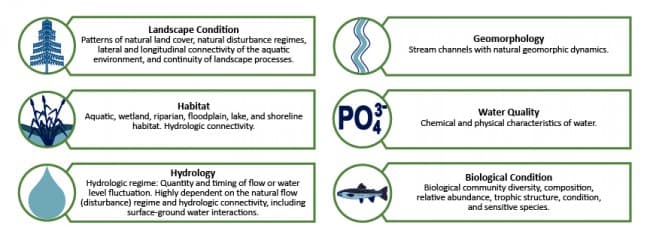Integrated Assessments of Watershed Health
Demonstrating the connections between aquatic ecosystem components and the landscape of which they are a part
The U.S. Environmental Protection Agency (EPA) launched the Healthy Watersheds Initiative to:
- Protect and maintain watersheds with natural, intact aquatic ecosystems.
- Prevent them from becoming impaired.
- Accelerate restoration successes.
Cadmus designs and conducts integrated assessments of watershed health and vulnerability as part of our support to the Initiative. Integrated assessments evaluate landscape condition, hydrology, fluvial geomorphology, habitat, water chemistry, and biotic communities in recognition that aquatic ecosystems function as interconnected systems within a larger watershed, landscape, and temporal context. These assessments build on previous work conducted by the states and their partners and use existing data to demonstrate the connections between aquatic ecosystem components and the landscape of which they are a part.
Cadmus is currently conducting watershed health assessments at the statewide level for California, Wisconsin, and Alabama and at the watershed level for the Mobile Bay Watershed and the Clinch-Powell Watershed.
For the statewide assessments, Cadmus designed and is implementing a statistical modeling approach for predicting ecological indicator values in every stream reach. This approach relies on the use of a combination of statistical and machine-learning algorithms that are able to accommodate the many idiosyncrasies of environmental data while elucidating the complex relationships between watershed characteristics (such as land cover, soils, and geology) and instream measures of ecological health (such as macroinvertebrate species compositions, nutrient concentrations, and the natural streamflow regime).
For both the statewide and watershed-scale assessments, Cadmus employs innovative spatial analysis techniques to:
- Delineate the active river area.
- Model hydrogeomorphic connectivity between the landscape and stream network.
- Conduct land-use change analyses.
These analyses are often conducted with high-resolution LiDAR elevation data and employ custom Python scripts to handle extremely large spatial datasets. The results of these spatial analyses are often summarized at the stream reach catchment scale and analyzed within a watershed framework, using custom code to generate values for upstream watershed characteristics in every stream reach.
The results of the watershed health assessments include an index that assigns one score representing overall watershed health to each HUC12 watershed in the state or watershed. These results will provide for a more comprehensive and coordinated approach to setting priorities for protection and restoration.
